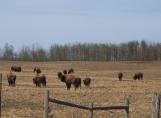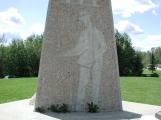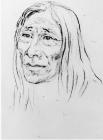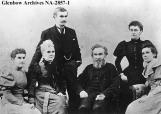14
Gerald Hutchinson:... And so Rundle translated hymns, texts and prayers in Cree. So they had that as a start for mission work. He would write out what he called a Sunday Book. The people would take it home with them. And if only one person in the camp learned how to read this picture language, he could read it out to the rest of the band. So the knowledge that he was trying to convey of gospel-- through hymns, prayers and such-- was conveyed to Aboriginal people in their own language under their own leadership. Each camp developed its own reader and leader and there was no domination or threat that was used in evangelizing-- it was largely something that First Nations took on themselves and used.
15
Note from Maskipiton to Robert Rundle, in which he asks to teach his son Benjamin English.28 December 1844
Central Alberta

16
Gerald Hutchinson:... By December of '44, Maskipiton was writing letters to Rundle. And we have one copy of his, of a letter that Maskipiton wrote to Rundle in picture language. Syllabics spread through all of those camps. It took longer for it to move north but in this region it was just used very quickly.
18
During these same years, the hunting of animals for fur resulted in a decline of animals for food. Fort Edmonton's chief factor John Rowand left written accounts of famine and starvation, resulting in many deaths and creating tensions among people on the land, but also between the missionaries and the Company in its role in the situation. The young Methodist missionary wanted to respond to this desperation.20
Gerald Hutchinson:… For Rundle the good news was showing somebody that they could plant seeds and grow food. And he longed for a place to do it. He couldn't get permission to proceed with that plan because of tensions developing between James Evans, Rundle's superintendent and the Company. And as long was Evans was involved, little else would happen in terms of missions. It was only after Evans died in 1846 that the Company would say "okay" [to a mission outside of Company's houses]. They sent an assistant out to work with Rundle and in turn, Rundle chose this place to begin the practice of agriculture in this region.
22
In planting potatoes and beans, Rundle realized that the soils of the region were limited for agricultural production. But in establishing the Pigeon Lake mission, he moved beyond the immediate supervision and influence of the Company.In 1846, Rundle tried to return to England on furlough and to find a wife. The request was denied. Supporting a missionary family in the field was expensive. Rather than being dejected, Rundle immersed himself further into the mission work.
24
The Cree chief Maskipiton presented Rundle with the idea of travelling south to the border and visiting First Nations encampments along the way, escorted by Maskipiton himself. John Rowand gave Rundle one of his best horses for the trip. On the return journey, while investigating rumours of a massacre along the Battle River, Rundle was thrown from the horse and broke his left wrist.25
Note from Cree Chief Maskipiton to The Reverend James Evans in Norway House.6 September 1844
Central Alberta
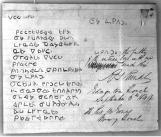
26
Gerald Hutchinson:... I would look at that trip as the prime achievement of the time that he was here- evidence of his sound acceptance in the native community. That Maskipiton would want to do that, dare do that and did do that, laid a foundation that was just astonishing. And you could look at it and say, "What a shame he should break his arm then and have to leave." But it did certainly establish the whole base of the First Nations church from that point on, from here to the area of the present Old Man River Dam.
